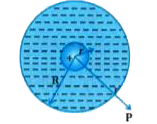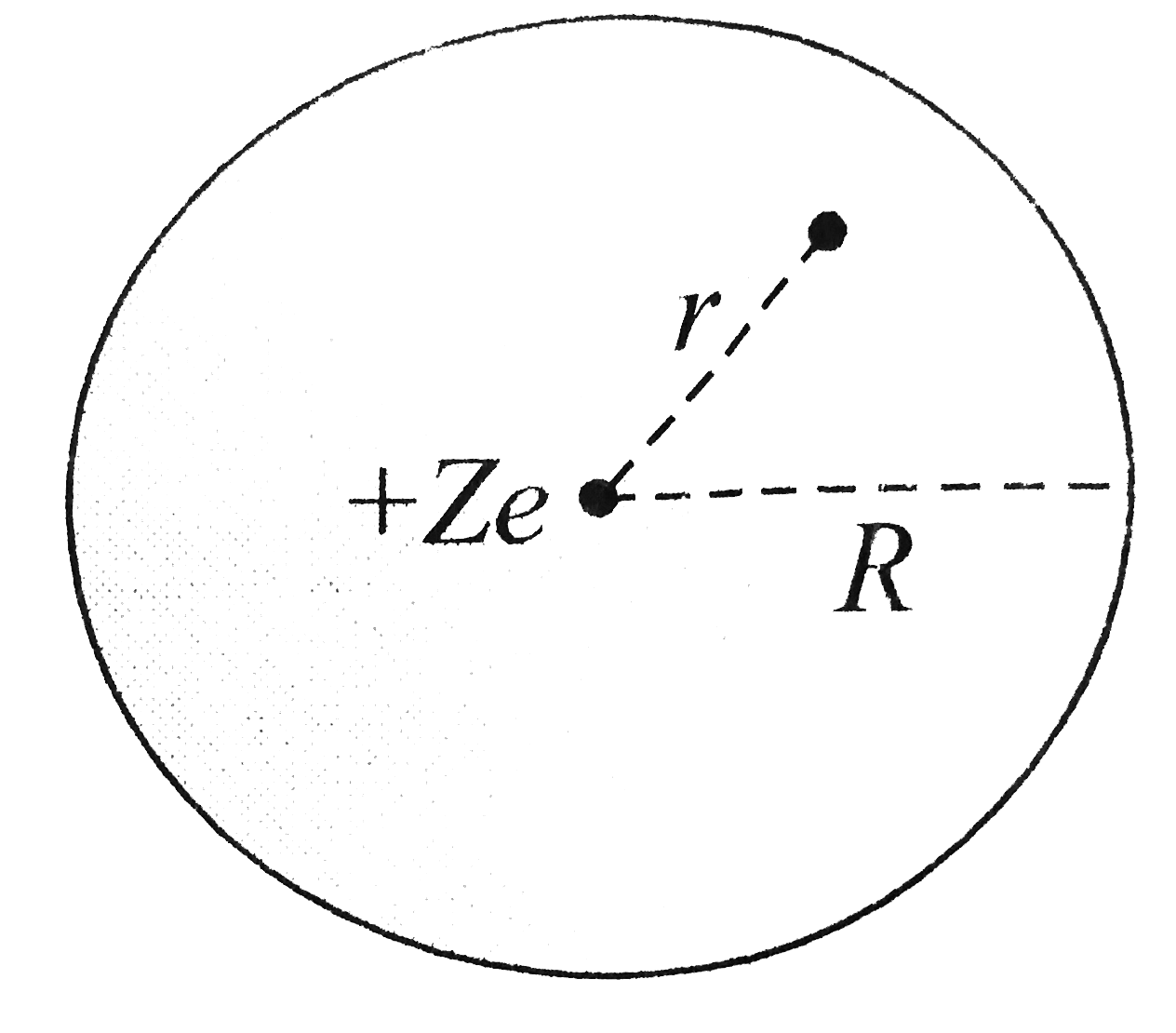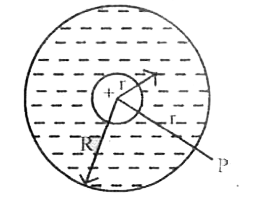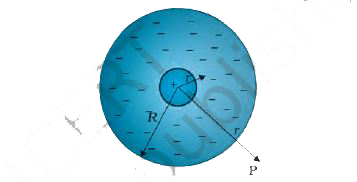An early model for an atom considered it to have a positively charged point nucleus of charge Ze, surrounded by a uniform density of negative charge up to a radius R. The atom as a whole is neutral. For this model, what is the electric field at a distance r from the nucleus ?
 Solution in Gujrati
Solution in Gujrati
The charge distribution for this model of the atom is as the total charge in the uniform sperical of charge z e + negative harge is neutral this immedialtely gives us the negative charge density p since we must have
4πR33p=0−Ze
to fin d the electric field E(r ) at a point P which is a distance r away from the nucleus we use gauss law its direction is along the radius vector r from the origin to the point the obvious gaussian surface is a spherical surface centred to the point P the obvious gaussian surface is a spherical surface centred at the nucleus we consider two situation namely r>R and r<R
(i) r>R the electric flux Φ enclosed by the spherical surface is Φ=E(r)×4πr2
where E(r ) is the magnitude of the electric field at r this is because the field at any point on the spherical and has the same magnitude at all points on the surface
i.e q=Ze+4πr33P
substituting for the charge density p obtained earlier we have M
(ii) r>R in this case the total enclosed by the gaussian sperical surface is zero since the atom is neutral thus from gauss law
at r =R both cases given the same result E =0
Topper's Solved these Questions
- ELECTRIC CHARGES AND FIELDS BOOK - NCERT GUJARATICHAPTER - ELECTRIC CHARGES AND FIELDS EXERCISE - EXERCISES
34 Videos
- DUAL NATURE OF RADIATION AND MATTERBOOK - NCERT GUJARATICHAPTER - DUAL NATURE OF RADIATION AND MATTEREXERCISE - EXERCISES
41 Videos
- ELECTROMAGNETIC INDUCTIONBOOK - NCERT GUJARATICHAPTER - ELECTROMAGNETIC INDUCTIONEXERCISE - ADDITIONAL EXERCISES
7 Videos
Similar Questions
What is the force between two small charged speres having charges of 2×10−7 c and 3×10−7 c placed 30 cm apart in air
View SolutionFind the
(a) maximum frequency, and
(b) minimum wavelength of X-rays produced by 30 kv electrons.
View SolutionSuppose the loop is stationary but the current feeding the electromagnet that produces the magnetic field is gradually reduced so that the field decreases from its initial value of 0.3 T at the rate of 0.02 T s−1. If the cut is joined and the loop has a resistance of 1.6 Ω, how much power is dissipated by the loop as heat ? What is the source of this power ?
View SolutionAccording to early model of an atom, the atom is considered it to have a positively charged point nucleus of charge Ze surrounded by a uniform density of negative charge up to a radius R. The atom as a whole is neutral. The electric field at a distance r from the nucleus is (r<R)

View SolutionAn early model for an atom considered it to have a positively charged point nucleas of charge Ze, surrounded by a unifrom density of negative charge upto a radius R. The atom as a whole is neutral. For this model, What is the electric field at a distance r from the nucleas ?
View Solutionप्रारम्भ में परमाणु के मॉडल (atomic model) के लिए यह माना गया था कि प्रत्येक परमाणु +Ze आवेशयुक्त एक बिन्दुवत नाभिक (nucleus) होता है जो R त्रिज्या के गोले (sphere) तक उसी परिमाण के ऋण आवेश से एकसमान रूप से (uniformly) घिरा है ताकि परमाणु पूर्णरुमेण उदासीन (neutral) हो। इस मॉडल के लिए नाभिक से r दूरी पर विधुत-क्षेत्र ज्ञात करें, यदि (i) r>R तथा (ii) r<R
View SolutionAccording to early model of an atom,the atom is considered it to have a positively charged point nucleus of charge Ze surrounded by a uniform density of negative charge up to a radius R. The atom as a whole is neutral. The electric field at a distancer from the nucleus is (r<R)

View SolutionThe classical concept of atomic structure is that negative charges are uniformly distributed inside a sphere of radius R keeping the nucleus of positive charge Ze at the centre of that sphere. An atom as a whole is electrically neutral. find out the electric field at a distance r from the nucleus, according do this atomic model.
View Solutionपरमाणु के प्रारंभिक प्रतिरूप में यह माना गया था कि आवेश Ze का बिंदु आमाप का घनात्मक नाभिक होता है जो त्रिज्या तक एकसमान घनत्व के ऋणावेश से घिरा हुआ है। परमाणु पूर्ण रूप में विधुत उदासीन है। इस प्रतिरूप के नाभिक से r दूरी पर विधुत क्षेत्र कितना है ?

View SolutionAn early model for an atom considered to have a positively charged point nucleus of charge Ze surrounded by a uniform density of negative charge up to a radius R. The atom as a whole is neutral. For this model, what is the electric field a distance r from the nucleus, where r>R ?
View SolutionAn early model for an atom consider it to have a positively charged point inucleus of charges ze surronded by a whole is neutral for this model what is the electric field at a distance r from the nucleus

View SolutionAn atom was earlier assumed to be sphere of radius a having a positively charged point nucleus of charge +Ze at its centre . This nucleus was believed to be surrounded by a uniform desity of negative charge that made the atom neutral as a whole.
Use this theorem to find the electric field of this atom at a distance r(r>a) from the centre of the atom.
View SolutionAccording to early model of an atom,the atom is considered it to have a positively charged point nucleus of charge Ze surrounded by a uniform density of negative charge up to a radius R. The atom as a whole is neutral. The electric field at a distancer from the nucleus is (r<R)

View SolutionAn early model for an atom considered it to have a positivelly charged point nucleus of charge +Ze surrounded by a uniform density of negative charge up to a radius R. The atom as whole is neutral. For this model , what is the electric field at a distance r from the nucleus when r lt R r =R ?Use Gauss's theorem
View SolutionAn early model for an atom considered it to have a positively charged point nucleus of charge Ze, surrounded by a uniform density of negative charge up to a radius R. The atom as a whole is neutral. For this model, what is the electric field at a distance r from the nucleus ?
View Solution
